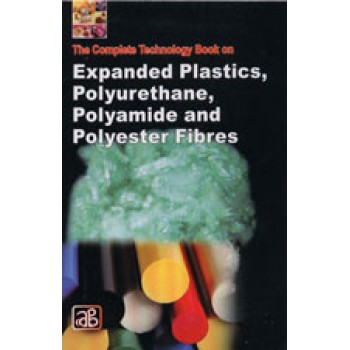The Complete Technology Book on Expanded Plastics, Polyurethane, Polyamide and Polyester Fibres
| Price: | Rs.1,275.00 |
Detail Of The Complete Technology Book on Expanded Plastics, Polyurethane, Polyamide and Polyester Fibres
| ISBN | 8178330016 |
| Pages | 544 |
| Language: | English |
| Product Code: | 1 |
| Size(in cm): | 21*13.5 cm |
| Weight(in grams): | 500(approx) |
Description:
Expanded plastics are also known as foamed plastics or cellular plastics. Expanded plastics can be flexible, semi flexible, semi rigid or rigid. They can also be thermoplastic or thermosetting and can exist as open celled or closed celled materials. Expanded plastics may be prepared from most synthetic and many natural polymers. Most of the industrially important ones are made from polystyrene, polyvinyl chloride, polyurethanes and polyethylene, as well as from resins that derive from phenol, epoxy, etc. Polyurethane (PUR and PU) is polymer composed of a chain of organic units joined by carbamate (urethane) links. Polyurethane polymers are formed by combining two bi or higher functional monomers. One contains two or more isocyanate functional groups and the other contains two or more hydroxyl groups. More complicated monomers are also used.The Polyurethanes are among the most recent additions to the many commercially important classes of polymers. Urethanes can be considered esters of the unstable carbamics acid or amide esters of carbonic acid. A polyamide is a polymer containing monomers of amides joined by peptide bonds. They can occur both naturally and artificially, examples being proteins, such as wool and silk, and can be made artificially through step growth polymerization or solid phase synthesis. Polyamides are commonly used in textiles, automotives, carpet and sportswear due to their extreme durability and strength. Polyester is a category of polymers which contain the ester functional group in their main chain. Natural polyesters and a few synthetic ones are biodegradable, but most synthetic polyesters are not. Polyester fibres are produced by the melt spinning process. Raw materials are heated to a spinning mass, which is then pressed through spinnerets. Manufacturing techniques are now developed to the point where they can produce fibres adapted to suit the widest possible applications: they can have round, oval or angular profiles, making them firm to the touch. Applications of these polymers are in various fields like rubber industry, textile industry, chemical industries etc.
Some of the fundamentals of the book are epoxy curing system, background, process conditions, polyether polyols with epoxy resins, highlights of the technological achievement, laminates comprising a hard foam layer and a fiber reinforced synthetic resin layer, highlights of the technological achievement, process conditions, plastic deformation, modification of amino polyols with epoxy resins, producing expanded and cured polyester resin, foamed unsaturated polyester resins with gel coat, cross linked polyester, unsaturated polyester compositions with high impact strength, foam crystallization of condensation polymers, acrylate rubber modification of aromatic polyesters etc.
The present book covers processes of expanded plastics, polyurethane, polyamides with other related information required by an entrepreneur. This book is very useful for technocrats, researchers, entrepreneurs and professionals.
Reviews (0)
Write a review
Your Name:Your Review:
Note: HTML is not translated!
Rating: Bad Good
Enter the code in the box below:



 |
| 